The Samsung 850 EVO 4TB SSD Review
by Billy Tallis on July 11, 2016 10:00 AM ESTMixed Random Read/Write Performance
The mixed random I/O benchmark starts with a pure read test and gradually increases the proportion of writes, finishing with pure writes. The queue depth is 3 for the entire test and each subtest lasts for 3 minutes, for a total test duration of 18 minutes. As with the pure random write test, this test is restricted to a 16GB span of the drive, which is empty save for the 16GB test file.
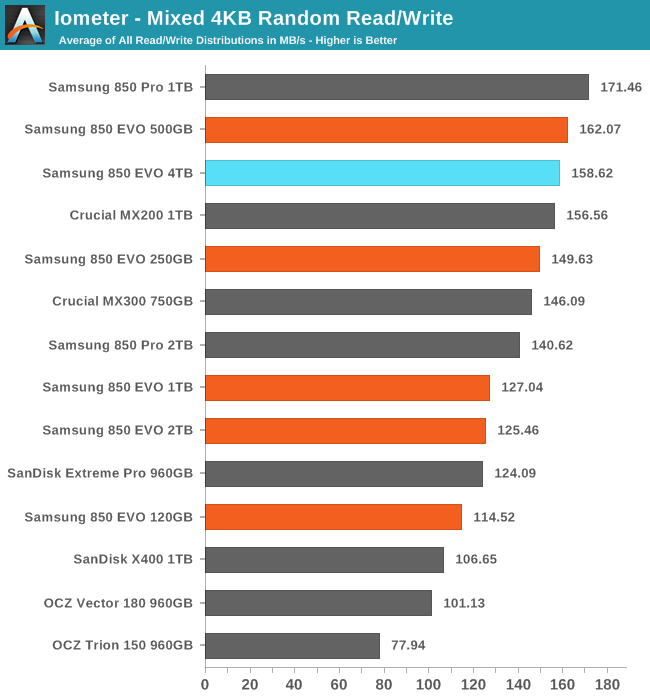
The mixed random I/O performance of the 4TB 850 EVO is much better than the other large 850 EVOs, putting te 4TB model close to the top of the chart.
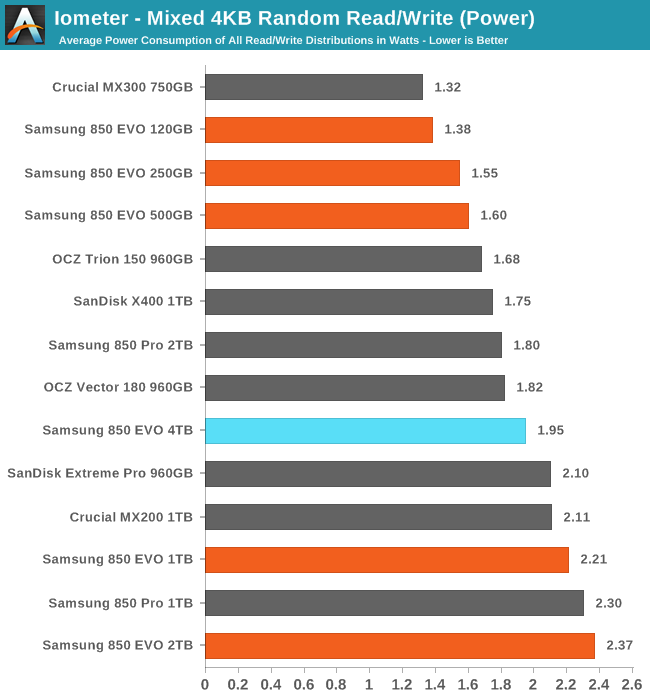
The 4TB 850 EVO also manages a large reduction in power usage as compared with the 1TB and 2TB 850 EVOs, making the 4TB much more efficient.
 |
|||||||||
Unlike the other 850 EVOs, the 4TB never loses performance as the proportion of writes in the test workload increases. Meanwhile, the power draw is essentially constant until near the end of the test.
Mixed Sequential Read/Write Performance
The mixed sequential access test covers the entire span of the drive and uses a queue depth of one. It starts with a pure read test and gradually increases the proportion of writes, finishing with pure writes. Each subtest lasts for 3 minutes, for a total test duration of 18 minutes. The drive is filled before the test starts.
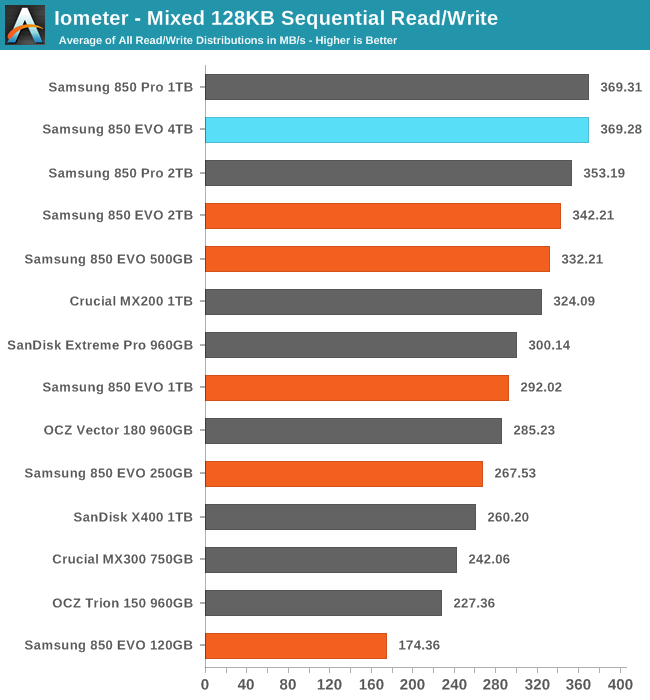
The 4TB 850 EVO is essentially tied for the best mixed sequential read and write performance.
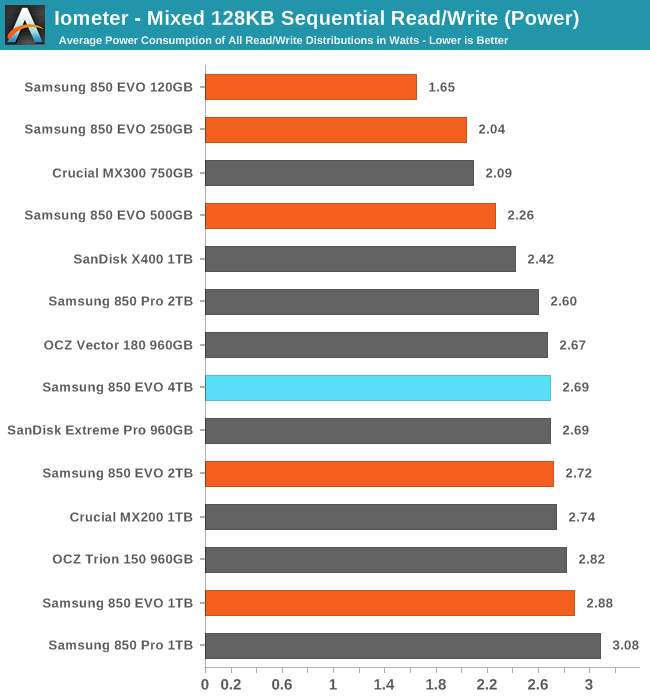
The 4TB 850 EVO averages using slightly less power than the 2TB model, and it is one of the most efficient of the large drives.
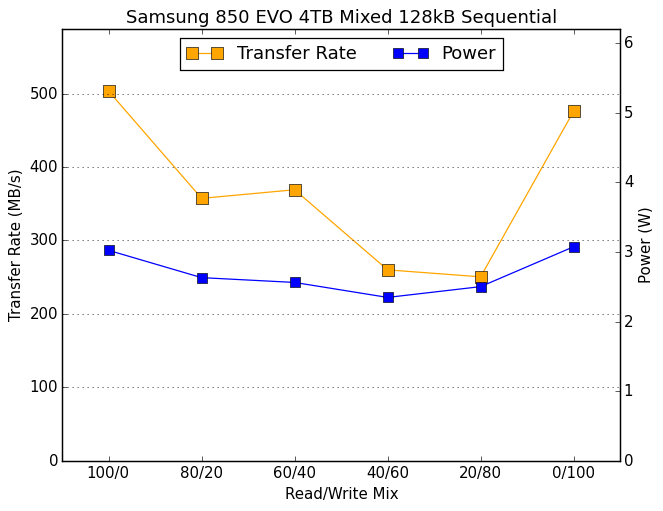 |
|||||||||
The usual pattern is for performance on this test to resemble a bathtub curve, but the 2TB 850s and the 4TB 850 EVO don't lose as much of their performance during the first half of the test, leading them to bottom out much later than most other drives.










145 Comments
View All Comments
profquatermass - Tuesday, August 9, 2016 - link
6GB? My first hard drive was 200MB!bug77 - Tuesday, July 12, 2016 - link
Yeah, if you can get one of these at half the MSRP, it's only $750 :rolleyes:Flunk - Monday, July 11, 2016 - link
It's only $0.36 a GB, that's pretty cheap.patrickjp93 - Monday, July 11, 2016 - link
You can get something like the Sandisk Ultra II 1TB for 21 cents/GB.ddriver - Monday, July 11, 2016 - link
But then again why would you? Unless you are starving, and if you are, then you wouldn't be buying SSDs...I can't honestly think of any good reason to buy something other than samsung SSD - they have the most warranty and performance is top notch too, reliability seems to be better too.
FLHerne - Monday, July 11, 2016 - link
Support and spec compliance. Samsung *still* ship firmware that claims support for queued TRIM ATA commands, but erases data if they're actually used. The consistent response is "Windows doesn't use these commands, we don't support other OS's", never mind that it's part of the SATA spec.(no, the kernel bug they fixed is completely unrelated)
I *hate* manufacturers treating "works in current Windows" as an acceptable spec - it's guaranteed to shoot you in the foot down the line, as everyone saw with Vista. So I bought a SanDisk instead.
FLHerne - Monday, July 11, 2016 - link
To clarify, I mean the way Vista broke all the manufacturers' stupid assumptions based on XP's behaviour.Also, the months it took for them to bodge around the performance degradation.
Notmyusualid - Tuesday, July 12, 2016 - link
Acutally, I hate to back up Microsoft, but they DID say it was a complete re-write of Windows, and that it would not be the same OS at all.It performed horribly with low amounts of RAM, and at the time, the big RAM makers were in collusion over RAM price fixing (look it up), so that is why we saw laptops, with Vista being shipped with 256MB of RAM, which was a mess, I agree.
But someone like myself, who had way more RAM than that, found it to be just fine. And it was way less infected than XP too.
I guess your printer never received a Vista driver then? Too bad.
But for me, and other client workstations with reasonable amounts of installed RAM I oversaw, it worked just fine, from the first day I used it.
Flame away...
kepler- - Wednesday, July 13, 2016 - link
Except they lied. Go onto your desktop and try to make a folder called "con". You can't, even on Windows 10, because they are still using code from Windows for Workgroups.There are a few others that (PRN, AUX, NUL, COM1...), which are all legacy Windows device names. They never '"rewrote" anything from the ground up.
Michael Bay - Thursday, July 14, 2016 - link
Oy vey, muh geschafts can`t go into appropriate folders now!Such shoah.